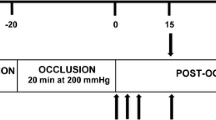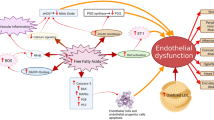Abstract
It has previously been shown that acute elevation of long-chain fatty acids (LCFA) impairs endothelium-dependent vasodilation (EDV) in humans. In this study, we tested the hypothesis that an elevation of both medium-chain fatty acids (MCFA) and LCFA affects the endothelium differently from LCFA elevation alone. Ten healthy volunteers received an intravenous infusion of Structolipid≿ (structured TG, MCFA/LCFA ratio 1∶1) and heparin for 2 h, while another 10 subjects received an infusion of Intralipid≿ (LCFA only) and heparin. EDV and endothelium-independent vasodilation (EIDV) were studied in the forearm after local administration of methacholine chloride (2 and 4 μg/min) and sodium nitroprusside (5 and 10 μg/min). Forearm blood flow was determined by venous occlusion plethysmography. Intralipid and heparin increased circulating FA levels from 0.2±0.1 to 1.4±0.5 mmol/L (P<0.001) and reduced EDV by 20% (P<0.01). Although Structolipid and heparin increased circulating FA levels to a similar extent (from 0.4±0.1 to 1.8±0.4 mmol/L after 2 h), EDV was not significantly changed. EIDV increased slightly during both interventions (P<0.05). In conclusion, an acute elevation of LCFA attenuated EDV, whereas an elevation of both MCFA and LCFA did not influence EDV. Thus, FA composition seems to be of importance for EDV in healthy humans.
Similar content being viewed by others
Abbreviations
- COX:
-
cyclooxygenase
- EDV:
-
endothelium-dependent vasodilation
- EIDV:
-
endothelium-independent vasodilation
- FBF:
-
forearm blood flow
- LCFA:
-
long-chain fatty acids
- MCFA:
-
medium-chain fatty acids
- Mch:
-
methacholine chloride
- NEFA:
-
nonesterified fatty acids
- PG:
-
prostaglandin
- RIA:
-
radioimmunoassay
- SNP:
-
sodium nitroprusside
- TX:
-
thromboxane
- VSMC:
-
vascular smooth muscle cell
References
Steinberg, H.O., Tarshoby, M., Monestel, R., Hook, G., Cronin, J., Johnson, A., Bayazeed, B., and Baron, A.D. (1997) Elevated Circulating Free Fatty Acid Levels Impair Endothelium-Dependent Vasodilation, J. Clin. Invest. 100, 1230–1239.
Lundman, P., Eriksson, M., Schenck-Gustafsson, K., Karpe, F., and Tornvall, P. (1997) Transient Triglyceridemia Decreases Vascular Reactivity in Young, Healthy Men Without Risk Factors for Coronary Heart Disease, Circulation 96, 3266–3268.
Lind, L., Fugmann, A., Branth, S., Vessby, B., Millgård, J., Berne, C., and Lithell, H. (2000) The Impairment in Endothelial Function Induced by Non-esterified Fatty Acids Can Be Reversed by Insulin, Clin. Sci. 99, 169–174.
de Kreutzenberg, S.V., Crepaldi, C., Marchetto, S., Calo, L., Tiengo, A., Del Prato, S., and Avogaro, A. (2000) Plasma Free Fatty Acids and Endothelium-Dependent Vasodilation: Effect of Chain-Length and Cyclooxygenase Inhibition, J. Clin. Endocrinol. Metab. 85, 793–798.
Paolisso, G., Gambardella, A., Tagliamonte, M.R., Saccomanno, F., Salvatore, T., Gualdiero, P., D’Onofrio, M.V., and Howard, B.V. (1996), Does Free Fatty Acid Infusion Impar Insulin Action Also Through an Increase in Oxidative Stress? J. Clin. Endocrinol. Metab. 81, 4244–4248.
Sarabi, M., Vessby, B., Millgård, J., and Lind, L. (2001) Endothelium-Dependent Vasodilation Is Related to the Fatty Acid Composition of Serum Lipids in Healthy Subjects, Atherosclerosis 156, 349–355.
Ignarro, L.J., Harbison, R.G., Wood, K.S., and Kadowitz, P.J. (1986) Activation of Purified Soluble Guanylate Cyclase by Endothelium-Derived Relaxing Factor from Intrapulmonary Artery and Vein: Stimulation by Acetylcholine, Bradykinin and Arachidonic Acid, J. Pharmacol. Exp. Ther. 237, 893–900.
Moers, A., and Schrezenmeir, J. (1997) Palmitic Acid but Not Stearic Acid Inhibits NO-Production in Endothelial Cells, Exp. Clin. Endocrinol. Diabetes 105, 78–80.
Davda, R.K., Stepniakowski, K.T., Lu, G., Ullian, M.E., Goodfriend, T.L., and Egan, B.M. (1995) Oleic Acid Inhibits Endothelial Nitric Oxide Synthase by a Protein Kinase C-Independent Mechanism, Hypertension 26, 764–770.
Miettinen, T.A., Naukkarinen, V., Huttunen, J.K., Mattila, S., and Kumlin, T. (1982) Fatty-Acid Composition of Serum Lipids Predicts Myocardial Infarction, Br. Med. J. 285, 993–996.
Öhrvall, M., Berglund, L., Salminen, I., Lithell, H., Aro, A., and Vessby, B. (1996) The Serum Cholesterol Ester Fatty Acid Composition but Not the Serum Concentration of α-Tocopherol Predicts the Development of Myocardial Infarction in 50-Year-Old Men: 19 Years Follow-up, Atherosclerosis 127, 65–71.
Lind, L., Sarabi, M., and Millgård, J. (1998) Methodological Aspects of the Evaluation of Endothelium-Dependent Vasodilation in the Human Forearm, Clin. Physiol. 18, 81–87.
Lind, L., Hall, J., Larsson, A., Annuk, M., Fellström, B., and Lithell, H. (2000) Evaluation of Endothelium Dependent Vasodilation in the Human Peripheral Circulation, Clin. Physiol 20, 440–448.
Boberg, M., Croon, L.B., Gustafsson, I.B., and Vessby, B. (1985) Platelet Fatty Acid Composition in Relation to Fatty Acid Composition in Plasma and to Serum Lipoprotein Lipids in Healthy Subjects with Special Reference to the Linoleic Acid Pathway, Clin. Sci. 68, 581–587.
Öhrvall, M., Tengblad, S., and Vessby, B. (1993) Lower Tocopherol Serum Levels in Subjects with Abdominal Adiposity, J. Intern. Med. 234, 53–60.
Thurnham, D.I., Davies, J.A., Crump, B.J., Situnayake, R.D., and Davis, M. (1986) The Use of Different Lipids to Express Serum Tocopherol: Lipid Ratios for the Measurement of Vitamin E Status, Ann. Clin. Biochem. 23, 514–520.
Basu, S. (1998) Radioimmunoassay of 8-Iso-prostaglandin F2α: An Index for Oxidative Injury via Free Radical Catalysed Lipid Peroxidation, Prostaglandins Leukot. Essent. Fatty Acids 58, 319–325.
Wu, G.H., Jarstrand, C., and Nordenstrom, J. (1999) Phagocyte-Induced Lipid Peroxidation of Different Intravenous Fat Emulsions and Counteractive Effect of Vitamin E, Nutrition 15, 359–364.
Shimokawa, H., and Vanhoutte, P.M. (1989) Dietary Omega 3 Fatty Acids and Endothelium-Dependent Relaxations in Porcine Coronary Arteries, Am. J. Physiol. 256, H968–H973.
Juan, H., and Sametz, W. (1986) Vasoconstriction Induced by Noradrenaline and Angiotensin II Is Antagonized by Eicosapentaenoic Acid Independent of Formation of Trienoic Eicosanoids, Naunyn Schmiedebergs Arch. Pharmacol. 332, 288–292.
Miller, V.M., and Vanhoutte, P.M. (1985) Endothelium-Dependent Contractions to Arachidonic Acid Are Mediated by Products of Cyclooxygenase, Am. J. Physiol. 248, H432–H437.
Kontos, H.A., Wei, E.P., Ellis, E.F., Jenkins, L.W., Povlishock, J.T., Rowe, G.T., and Hess, M.L. (1985) Appearance of Superoxide Anion Radical in Cerebral Extracellular Space During Increased Prostaglandin Synthesis in Cats, Circ. Res. 57, 142–151.
Beckman, J.S., and Koppenol, W.H. (1996) Nitric Oxide. Superoxide, and Peroxynitrite: The Good, the Bad, and Ugly, Am. J. Physiol. 271, C1424-C1437.
Taddei, S., Virdis, A., Ghiadoni, L., Magagna, A., and Salvetti, A. (1997) Cyclooxygenase Inhibition Restores Nitric Oxide Activity in Essential Hypertension, Hypertension 29, 274–279.
Bouchard, J.F., and Lamontagne, D. (1999) Mechanisms of Protection Afforded by Cyclooxygenase Inhibitors to Endothelial Function Against Ischemic Injury in Rat Isolated Hearts, J. Cardiovasc. Pharmacol. 34, 755–763.
Steer, P., Millgård, J., Basu, S., Lithell, H., Vessby, B., Berne, C., and Lind, L., Vitamin C, Diclophenac, and l-Arginine Protect Endothelium-Dependent Vasodilation Against Elevated Circulating Fatty Acid Levels in Humans, Atherosclerosis (in press).
de Man, F.H., Weverling-Rijnsburger, A.W., van der Laarse, A., Smelt, A.H., Jukema, J.W., and Blauw, G.J. (2000) Not Acute but Chronic Hypertriglyceridemia Is Associated with Impaired Endothelium-Dependent Vasodilation: Reversal After Lipid-Lowering Therapy by Atorvastatin, Arterioscler. Thromb. Vasc. Biol. 20, 744–750.
Author information
Authors and Affiliations
Corresponding author
About this article
Cite this article
Steer, P., Basu, S., Lithell, H. et al. Acute elevations of medium-and long-chain fatty acids have different impacts on endothelium-dependent vasodilation in humans. Lipids 38, 15–19 (2003). https://doi.org/10.1007/s11745-003-1025-9
Received:
Revised:
Accepted:
Issue Date:
DOI: https://doi.org/10.1007/s11745-003-1025-9




